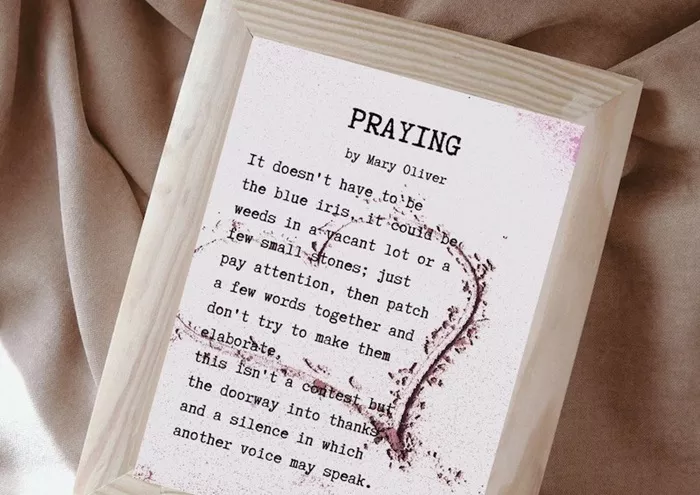Welcome to Poem of the Day – Praying by Mary Oliver
Mary Oliver’s poem “Praying” is a short yet profound meditation on the essence of prayer and the ways in which humans connect with the divine and nature. In this poem, Oliver uses clear, accessible language to explore the depth of spiritual life through the simple act of praying. It is a poem about reverence, reflection, and the awareness of the present moment.
Praying Poem
It doesn’t have to be
the blue iris, it could be
weeds in a vacant lot, or a few
small stones; just
pay attention, then patch
a few words together and don’t try
to make them elaborate, this isn’t
a contest but the doorway
into thanks, and a silence in which
another voice may speak.
Praying Explanation
Understanding the Title
The title of the poem, “Praying”, immediately sets the tone for its content. We might think of praying as a formal religious act, but Oliver expands the definition. The act of praying is not confined to a church or ritual; it can happen in the everyday interactions with nature and the world around us.
First Stanza: The Physicality of Prayer
In the opening lines of “Praying”, Oliver draws our attention to the physicality of the act of prayer. She describes prayer not as a mental or abstract activity, but something that involves the whole body. She writes, “It doesn’t have to be / the blue and silver of the sky…” This suggests that prayer isn’t confined to grand gestures or specific settings. Prayer can happen anywhere, even in the simplicity of the natural world, as long as we are open to it.
Oliver’s use of imagery here is striking. The mention of the sky represents a vast, uncontainable beauty, which contrasts with the ordinary world. This juxtaposition invites the reader to see prayer as an acknowledgment of beauty in both the divine and the mundane.
Second Stanza: A Simple Act of Attention
Oliver continues in the second stanza by focusing on how prayer is essentially an act of paying attention. She writes, “You only have to let the soft animal of your body / love what it loves.” This line reveals the simplicity of prayer. It doesn’t require complex rituals, only a conscious awareness of the present moment. The “soft animal of your body” refers to the natural, instinctual part of humans that is connected to the earth and its rhythms. Prayer, in this sense, becomes an act of alignment with one’s inner self and with the world around them.
The idea of “loving what it loves” suggests that prayer can be an expression of love, acceptance, and gratitude toward what is in front of us. Whether it’s nature, a loved one, or simply the act of living, Oliver invites us to notice and cherish those small, everyday miracles.
Third Stanza: Embracing the Moment
In the final stanza, Oliver emphasizes the power of being present. She suggests that prayer is not about asking for things but about being attuned to the world around us. “To me, this is prayer,” she says, pointing out that acknowledging the beauty and wonder of life in a moment of stillness is as much a prayer as any other act.
In this way, Oliver presents prayer as an experience of gratitude rather than a petition. It is a connection to both the sacred and the worldly. Through the simplicity of prayer, she finds a pathway to deeper understanding and peace.
Conclusion
Mary Oliver’s “Praying” is a meditation on the profound yet simple practice of prayer. By encouraging us to recognize prayer as an act of attention, love, and presence, she allows us to see that prayer does not need to be formal or distant from our everyday lives. Instead, it can be something that we carry with us in every moment, especially when we engage with the world around us.

